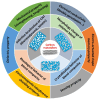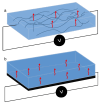Shape-Memory Polymers Based on Carbon Nanotube Composites
- PMID: 38930718
- PMCID: PMC11205355
- DOI: 10.3390/mi15060748
Shape-Memory Polymers Based on Carbon Nanotube Composites
Abstract
For the past two decades, researchers have been exploring the potential benefits of combining shape-memory polymers (SMP) with carbon nanotubes (CNT). By incorporating CNT as reinforcement in SMP, they have aimed to enhance the mechanical properties and improve shape fixity. However, the remarkable intrinsic properties of CNT have also opened up new paths for actuation mechanisms, including electro- and photo-thermal responses. This opens up possibilities for developing soft actuators that could lead to technological advancements in areas such as tissue engineering and soft robotics. SMP/CNT composites offer numerous advantages, including fast actuation, remote control, performance in challenging environments, complex shape deformations, and multifunctionality. This review provides an in-depth overview of the research conducted over the past few years on the production of SMP/CNT composites with both thermoset and thermoplastic matrices, with a focus on the unique contributions of CNT to the nanocomposite's response to external stimuli.
Keywords: carbon nanotubes; nanocomposites; shape-memory polymers; soft actuators.
Conflict of interest statement
The authors declare no conflicts of interest.
Figures













References
-
- Leng J.S., Lan X., Liu Y.J., Du S.Y. Shape-memory polymers and their composites: Stimulus methods and applications. Prog. Mater. Sci. 2011;56:1077–1135. doi: 10.1016/j.pmatsci.2011.03.001. - DOI
-
- Liu Y., Genzer J., Dickey M.D. “2D or not 2D”: Shape-programming polymer sheets. Prog. Polym. Sci. 2016;52:79–106. doi: 10.1016/j.progpolymsci.2015.09.001. - DOI
-
- Li Z.P., Olah A., Baer E. Micro- and nano-layered processing of new polymeric systems. Prog. Polym. Sci. 2020;102:101210. doi: 10.1016/j.progpolymsci.2020.101210. - DOI
-
- Behl M., Zotzmann J., Lendlein A. Shape-Memory Polymers. Springer; Berlin/Heidelberg, Germany: 2009. Shape-memory polymers and shape-changing polymers; pp. 1–40.
-
- Melly S.K., Liu L.W., Liu Y.J., Leng J.S. Active composites based on shape-memory polymers: Overview, fabrication methods, applications, and future prospects. J. Mater. Sci. 2020;55:10975–11051. doi: 10.1007/s10853-020-04761-w. - DOI
Publication types
Grants and funding
LinkOut - more resources
Full Text Sources
Miscellaneous

